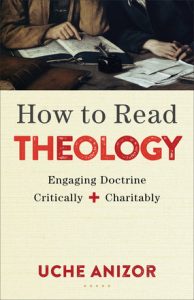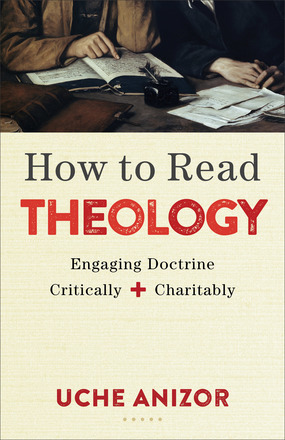Anizor, Uche. How to Read Theology: Engaging Doctrine Critically and Charitably. Grand Rapids, MI: Baker Academic, 2018, pp. 204, $22, softcover.
Reading theological literature critically and charitably is a necessary discipline for scholars, pastors, and students. How one goes about cultivating the appropriate skills to read in this way requires instruction and example. Uche Anizor (Ph.D. Wheaton College), associate professor of biblical and theological studies at Talbot School of Theology, Biola University, serves the academic community well in this primer where he addresses critical virtues for theological reading. Throughout its six chapters, Anizor’s straightforward argument addresses the need for and the instruction to reading critically and charitably. Part 1, “On Reading Charitably,” consists of two chapters, and Part 2, “On Reading Critically,” consists of four chapters. At the conclusion of these two parts, Anizor includes an epilogue where he further assists readers in applying his methodology. Here he provides examples of theological texts from which one should choose to implement his proposed strategies for critical and charitable reading, even guiding readers through the questions and steps one should expect throughout the process.
In chapters one and two, Anizor describes the challenges associated with reading theology charitably, noting the critical importance of understanding the primary role of context for theological reading. In chapter one, Anizor identifies four enemies to charitable reading: pride, suspicion, favoritism, and impatience. Each of these enemies stifle effective reading, but further, their presence poisons the readers apprehension and appreciation of theological writing. Against pride, Anizor urges humility for it “prompts me to recognize that I do not have the market concerned on theological truth, but that I am in constant need of the palliative breeze of other, diverse voices blowing through my mind” (p. 10). Reading suspiciously is to read while not considering the best of others (p. 11), ultimately leading one to magnify bad qualities while minimizing the good (p. 12). Against suspicion, Anizor urges readers to approach theological authors with a “sympathetic embrace” (p. 14). This posture is born out of love, which “is not crippled by fear, a close correlate of suspicion” (p. 12), and careful work to avoid suspicion in theological reading allows the reader to avoid imputing bad motives to another. Instead of favoritism, readers must cultivate the requisite skills to give a fair hearing to those espousing alternative views. Finally, impatience emerges most often when readers fail to embrace a patient undertaking of theological meaning, often rushing to find application. These four obstacles affect theological readers from every background, from the lay person to the senior scholar. Anizor’s counsel helpfully locates and instructs readers to a better way.
Chapter two’s importance could hardly be overstated, for here Anizor explains the importance of context when wrestling with theological literature. “Theology is written from within a context,” Anizor claims, “and therefore bears certain contextual marks that must be attended to if we are to understand and assess it well” (p. 28). Anizor focuses on the issues of historical context (one’s culture), ecclesial context (one’s church tradition), and the polemical context (the presence of conflict). Using examples from Barth, Moltmann, Gutiérrez, and Bonhoeffer, Anizor demonstrates why these contextual realms prove critical in reading a theologian’s work critically and charitably.
Chapters four through six apply these practices through the four sources of theology: Scripture, Tradition, Reason, and Experience. In these chapters readers are instructed to avoid the errors of proof-texting, and Anizor gives careful instruction on how to apply Scripture to theology. Anizor provides readers with a seven point outline for how one should go about assessing doctrinal constructions through the lens of Scripture. On tradition, theological reading must assess and learn from historical developments of doctrine and the practices those doctrines created. Anizor helps readers think through tradition by overviewing creeds, confessions, doctors (theologians), and other teachers (Anizor’s description of the conversation partners one can experience). In his discussion of reason, Anizor demonstrates Christian theology’s view of faith and reason. He guides readers with principles on how to build sound arguments that remain true to Scripture and tradition.
Finally, Anizor (in perhaps the best chapter of the whole book) explains carefully the critical importance one’s experience has in theology, while also stating clearly the inherent dangers in allowing one’s experience to be given too great an importance over the previous three emphases (particularly Scripture). For Anizor, experience includes “religious and the nonreligious as well as the individual and the communal aspects of experience” (p. 154), but he insightfully demonstrates that experience not only contributes to theology’s content, it is also a consequence of theology. “Theology, if it is done well, should lead to an experience of the good, true, and beautiful” (p. 164).
Written as a primer, and written with students in mind, one can hardly quibble with Anizor’s instruction. Quite simply, this book should be required reading for students entering academic institutions (seminary, divinity school, graduate school, etc.) in preparation for academic or church-based ministry. Due in part to the ever-increasing toxicity in contemporary dialogue, students must cultivate convictions early on that theological reading can and must be pursued in the manner Anizor prescribes. Regarding Anizor’s instruction, students should apply his methodology by selecting both a theologian within his/her tradition and one from without. In this way, students might be further helped acknowledging their own biases and default reactions within their theological reading. Additionally, this book is organized in such a way that it could easily be incorporated into a mentoring relationship in academic and ecclesial settings.
Some seasoned scholars might underestimate the applicability for a primer on this subject to have relevance with their own practices, but Anizor demonstrates convincingly how theological students, both new and old, need frequent reassessments of their theological reading techniques. Theologians, pastors and ministers, and theological students are all prone to pride, and this ancient sin often manifests itself in how one approaches the work of others. For these reasons, books like Anizor’s give a needed antidote for the sort of reading that honors the dignity and contribution of all who participate in theological conversation. Although this book could be applied to any tradition, Evangelical students and faculty will find the most usefulness of the approaches Anizor advocates.
Justin McLendon
Grand Canyon University





